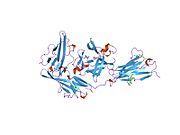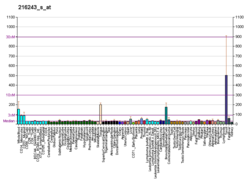Interleukin-1 receptor antagonist
| IL1RN | |||||||||||||||||||||||||||||||||||||||||||||||||||
|---|---|---|---|---|---|---|---|---|---|---|---|---|---|---|---|---|---|---|---|---|---|---|---|---|---|---|---|---|---|---|---|---|---|---|---|---|---|---|---|---|---|---|---|---|---|---|---|---|---|---|---|
 | |||||||||||||||||||||||||||||||||||||||||||||||||||
| |||||||||||||||||||||||||||||||||||||||||||||||||||
| Identifiers | |||||||||||||||||||||||||||||||||||||||||||||||||||
| Aliases | IL1RN, DIRA, ICIL-1RA, IL-1RN, IL-1ra, IL-1ra3, IL1F3, IL1RA, IRAP, MVCD4, interleukin 1 receptor antagonist | ||||||||||||||||||||||||||||||||||||||||||||||||||
| External IDs | OMIM: 147679; MGI: 96547; HomoloGene: 11163; GeneCards: IL1RN; OMA:IL1RN - orthologs | ||||||||||||||||||||||||||||||||||||||||||||||||||
| |||||||||||||||||||||||||||||||||||||||||||||||||||
| |||||||||||||||||||||||||||||||||||||||||||||||||||
| |||||||||||||||||||||||||||||||||||||||||||||||||||
| |||||||||||||||||||||||||||||||||||||||||||||||||||
| |||||||||||||||||||||||||||||||||||||||||||||||||||
| Wikidata | |||||||||||||||||||||||||||||||||||||||||||||||||||
| |||||||||||||||||||||||||||||||||||||||||||||||||||
The interleukin-1 receptor antagonist (IL-1RA) is a protein that in humans is encoded by the IL1RN gene.[5][6]
IL-1RA was initially called the IL-1 inhibitor and was discovered separately in 1984 by two independent laboratories.[7] IL-1RA is an agent that binds non-productively to the cell surface interleukin-1 receptor (IL-1R), the same receptor that binds interleukin 1 family (IL-1), preventing IL-1's from sending a signal to that cell.
Function
IL-1RA is a member of the interleukin 1 cytokine family. IL-1RA is secreted by various types of cells including immune cells, epithelial cells, and adipocytes, and is a natural inhibitor of the pro-inflammatory effect of IL1β.[8] This protein inhibits the activities of interleukin 1, alpha (IL1A) and interleukin 1, beta (IL1B), and modulates a variety of interleukin 1 related immune and inflammatory responses. This gene and five other closely related cytokine genes form a gene cluster spanning approximately 400 kb on chromosome 2. Four alternatively spliced transcript variants encoding distinct isoforms have been reported.[9]
Clinical significance
A polymorphism of this gene is reported to be associated with increased risk of osteoporotic fractures[10] and gastric cancer.[11]
Biallelic deleterious mutations in the IL1RN gene results in a rare autoinflammatory disease called deficiency of the interleukin-1–receptor antagonist (DIRA).[12] Variants of the IL1RN gene is also associated with risk of schizophrenia.[13][14] Elevated levels of IL-1RA has been found in serum of schizophrenia patients.[15]
In treatment of temporomandibular joint osteoarthritis (TMJOA) the messenger RNA (mRNA) of IL-1RA can be used. The IL-1RA mRNA reduces pain and joint inflammation by blocking inflammatory cascade signals that lead to osteoarthritis progression.[16]
A recombinant, slightly modified version of interleukin 1 receptor antagonist called anakinra is used in the treatment of rheumatoid arthritis, an autoimmune disease in which IL-1 plays a key role.[17] Anakinra differs from native human IL-1RA in that it has the addition of a single methionine residue at its amino terminus [18]
The cytoplasmic and secreted isoforms of IL-1RA can suppress tumors such as squamous cell carcinoma. The cytoplasmic isoform can protect epithelial cells from environmental factors and compete with IL1A in binding with receptors preventing activation. Then, the secreted isoform regulates IL1B in tumor microenvironments by inhibiting glycolysis of IL1B and proliferation of tumor cells, thus preventing the movement of tumor cells.[19]
Use in horses
Interleukin 1 receptor antagonist is used in horses for the treatment of equine lameness secondary to joint and soft-tissue injury. IL-1RA obstructs the IL1B inflammatory cascade rather than helping to restore damaged tissue.[20]
References
- ^ a b c GRCh38: Ensembl release 89: ENSG00000136689 – Ensembl, May 2017
- ^ a b c GRCm38: Ensembl release 89: ENSMUSG00000026981 – Ensembl, May 2017
- ^ "Human PubMed Reference:". National Center for Biotechnology Information, U.S. National Library of Medicine.
- ^ "Mouse PubMed Reference:". National Center for Biotechnology Information, U.S. National Library of Medicine.
- ^ Steinkasserer A, Spurr NK, Cox S, Jeggo P, Sim RB (July 1992). "The human IL-1 receptor antagonist gene (IL1RN) maps to chromosome 2q14-q21, in the region of the IL-1 alpha and IL-1 beta loci". Genomics. 13 (3): 654–657. doi:10.1016/0888-7543(92)90137-H. PMID 1386337.
- ^ Patterson D, Jones C, Hart I, Bleskan J, Berger R, Geyer D, et al. (January 1993). "The human interleukin-1 receptor antagonist (IL1RN) gene is located in the chromosome 2q14 region". Genomics. 15 (1): 173–176. doi:10.1006/geno.1993.1025. PMID 8432529.
- ^ Dinarello CA (December 1994). "The interleukin-1 family: 10 years of discovery". FASEB Journal. 8 (15): 1314–1325. doi:10.1096/fasebj.8.15.8001745. PMID 8001745. S2CID 10404996.
- ^ Perrier S, Darakhshan F, Hajduch E (November 2006). "IL-1 receptor antagonist in metabolic diseases: Dr Jekyll or Mr Hyde?". FEBS Letters. 580 (27): 6289–6294. Bibcode:2006FEBSL.580.6289P. doi:10.1016/j.febslet.2006.10.061. PMID 17097645. S2CID 23087836.
- ^ "Entrez Gene: IL1RN interleukin 1 receptor antagonist".
- ^ Langdahl BL, Løkke E, Carstens M, Stenkjaer LL, Eriksen EF (March 2000). "Osteoporotic fractures are associated with an 86-base pair repeat polymorphism in the interleukin-1--receptor antagonist gene but not with polymorphisms in the interleukin-1beta gene". Journal of Bone and Mineral Research. 15 (3): 402–414. doi:10.1359/jbmr.2000.15.3.402. PMID 10750554. S2CID 23035139.
- ^ El-Omar EM, Carrington M, Chow WH, McColl KE, Bream JH, Young HA, et al. (March 2000). "Interleukin-1 polymorphisms associated with increased risk of gastric cancer". Nature. 404 (6776): 398–402. Bibcode:2000Natur.404..398E. doi:10.1038/35006081. PMID 10746728. S2CID 1288472.
- ^ Aksentijevich I, Masters SL, Ferguson PJ, Dancey P, Frenkel J, van Royen-Kerkhoff A, et al. (June 2009). "An autoinflammatory disease with deficiency of the interleukin-1-receptor antagonist". The New England Journal of Medicine. 360 (23): 2426–2437. doi:10.1056/NEJMoa0807865. PMC 2876877. PMID 19494218.
- ^ Kim SJ, Lee HJ, Koo HG, Kim JW, Song JY, Kim MK, et al. (September 2004). "Impact of IL-1 receptor antagonist gene polymorphism on schizophrenia and bipolar disorder". Psychiatric Genetics. 14 (3): 165–167. doi:10.1097/00041444-200409000-00009. PMID 15318032. S2CID 43435475.
- ^ Zanardini R, Bocchio-Chiavetto L, Scassellati C, Bonvicini C, Tura GB, Rossi G, et al. (2003). "Association between IL-1beta -511C/T and IL-1RA (86bp)n repeats polymorphisms and schizophrenia". Journal of Psychiatric Research. 37 (6): 457–462. doi:10.1016/S0022-3956(03)00072-4. PMID 14563376.
- ^ Hope S, Melle I, Aukrust P, Steen NE, Birkenaes AB, Lorentzen S, et al. (November 2009). "Similar immune profile in bipolar disorder and schizophrenia: selective increase in soluble tumor necrosis factor receptor I and von Willebrand factor". Bipolar Disorders. 11 (7): 726–734. doi:10.1111/j.1399-5618.2009.00757.x. hdl:10852/34620. PMID 19839997.
- ^ Deng J, Fukushima Y, Nozaki K, Nakanishi H, Yada E, Terai Y, et al. (August 2022). "Anti-Inflammatory Therapy for Temporomandibular Joint Osteoarthritis Using mRNA Medicine Encoding Interleukin-1 Receptor Antagonist". Pharmaceutics. 14 (9): 1785. doi:10.3390/pharmaceutics14091785. PMC 9505648. PMID 36145533.
- ^ Mertens M, Singh JA (January 2009). "Anakinra for rheumatoid arthritis". The Cochrane Database of Systematic Reviews (1): CD005121. doi:10.1002/14651858.CD005121.pub3. PMID 19160248.
- ^ "Kineret (anakinra) injection, for subcutaneous use" (PDF). Swedish Orphan Biovitrum.
- ^ Ding Y, Yi J, Wang J, Sun Z (April 2023). "Interleukin-1 receptor antagonist: a promising cytokine against human squamous cell carcinomas". Heliyon. 9 (4): e14960. Bibcode:2023Heliy...914960D. doi:10.1016/j.heliyon.2023.e14960. PMC 10070157. PMID 37025835.
- ^ Smith EJ, Beaumont RE, McClellan A, Sze C, Palomino Lago E, Hazelgrove L, et al. (March 2023). "Tumour necrosis factor alpha, interleukin 1 beta and interferon gamma have detrimental effects on equine tenocytes that cannot be rescued by IL-1RA or mesenchymal stromal cell–derived factors". Cell and Tissue Research. 391 (3): 523–544. doi:10.1007/s00441-022-03726-6. ISSN 0302-766X. PMC 9974687. PMID 36543895.
Further reading
- Arend WP, Malyak M, Guthridge CJ, Gabay C (1998). "Interleukin-1 receptor antagonist: role in biology". Annual Review of Immunology. 16: 27–55. doi:10.1146/annurev.immunol.16.1.27. PMID 9597123.
- Adcock IM, Ito K (June 2000). "Molecular mechanisms of corticosteroid actions". Monaldi Archives for Chest Disease = Archivio Monaldi per le Malattie del Torace. 55 (3): 256–266. PMID 10948677.
- Arend WP (2003). "The balance between IL-1 and IL-1Ra in disease". Cytokine & Growth Factor Reviews. 13 (4–5): 323–340. doi:10.1016/S1359-6101(02)00020-5. PMID 12220547.
- Sehouli J, Mustea A, Könsgen D, Katsares I, Lichtenegger W (2003). "Polymorphism of IL-1 receptor antagonist gene: role in cancer". Anticancer Research. 22 (6A): 3421–3424. PMID 12530098.
- Kamangar F, Cheng C, Abnet CC, Rabkin CS (October 2006). "Interleukin-1B polymorphisms and gastric cancer risk--a meta-analysis". Cancer Epidemiology, Biomarkers & Prevention. 15 (10): 1920–1928. doi:10.1158/1055-9965.EPI-06-0267. PMID 17035400. S2CID 8542733.
External links
- Interleukin+1+Receptor+Antagonist+Protein at the U.S. National Library of Medicine Medical Subject Headings (MeSH)
- v
- t
- e
-
 1ilr: CRYSTAL STRUCTURE OF THE INTERLEUKIN-1 RECEPTOR ANTAGONIST
1ilr: CRYSTAL STRUCTURE OF THE INTERLEUKIN-1 RECEPTOR ANTAGONIST -
 1ira: COMPLEX OF THE INTERLEUKIN-1 RECEPTOR WITH THE INTERLEUKIN-1 RECEPTOR ANTAGONIST (IL1RA)
1ira: COMPLEX OF THE INTERLEUKIN-1 RECEPTOR WITH THE INTERLEUKIN-1 RECEPTOR ANTAGONIST (IL1RA) -
 1irp: SOLUTION STRUCTURE OF HUMAN INTERLEUKIN-1 RECEPTOR ANTAGONIST PROTEIN
1irp: SOLUTION STRUCTURE OF HUMAN INTERLEUKIN-1 RECEPTOR ANTAGONIST PROTEIN





















